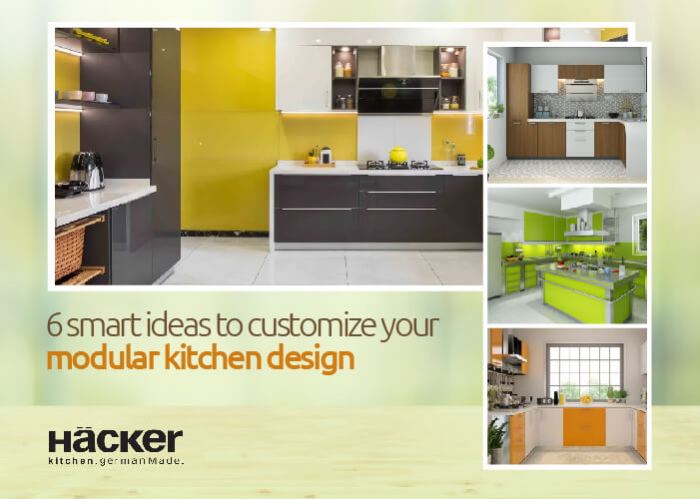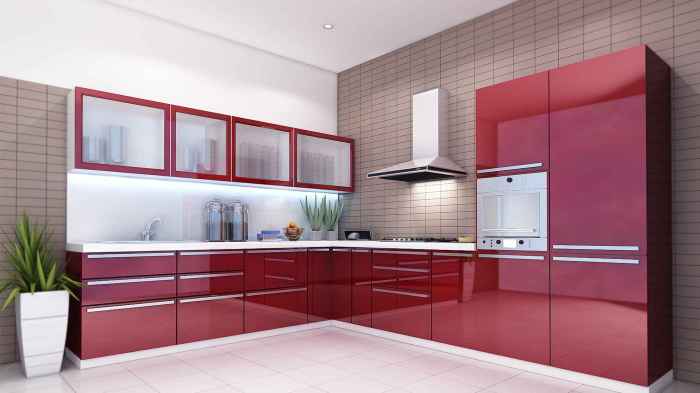Customizing Your Modular Kitchen to Fit Your Lifestyle: As the heart of the home, the kitchen should be a space that reflects your personal style and meets your specific needs. With modular kitchen designs, you have the flexibility to create a kitchen that is both functional and aesthetically pleasing.
In this guide, we will explore the benefits of modular kitchens, provide tips on tailoring them to your individual needs, and discuss the latest smart kitchen features that can enhance your cooking experience.
Modular Kitchen Customization Options
Modular kitchens have become increasingly popular in recent years, offering a range of benefits that make them a great choice for homeowners looking for a functional and stylish kitchen. These kitchens are made up of individual modules that can be combined in a variety of ways to create a custom kitchen that perfectly suits your needs and space.
One of the main advantages of modular kitchens is their flexibility. The modular design allows you to easily change the layout of your kitchen as your needs change. For example, if you decide to add an island or change the position of your appliances, you can simply rearrange the modules to create a new layout.
This flexibility makes modular kitchens a great option for people who are planning to remodel their kitchen in the future.
Another advantage of modular kitchens is their adaptability. Modular kitchens can be used in a variety of spaces, from small apartments to large homes. The modular design allows you to choose the modules that you need to create a kitchen that fits your space and your budget.
Modular Kitchen Components
Modular kitchens are made up of a variety of different components, including cabinets, drawers, countertops, and appliances. Each component is designed to perform a specific function, and can be combined in a variety of ways to create a custom kitchen.
- Cabinets:Cabinets are the most important part of any kitchen, and they provide storage for a variety of items, including dishes, cookware, and food.
- Drawers:Drawers are a great way to organize small items, and they can be used to store anything from utensils to spices.
- Countertops:Countertops provide a work surface for preparing food, and they can also be used to eat or entertain guests.
- Appliances:Appliances are essential for any kitchen, and they can include a variety of items, such as ovens, stoves, refrigerators, and dishwashers.
Tailoring to Individual Needs and Preferences
When customizing a modular kitchen, consider factors like lifestyle, cooking habits, and storage needs. Incorporate personal style through color schemes, cabinet designs, and hardware choices. Utilize space efficiently with corner units, pull-out drawers, and adjustable shelves. Design a kitchen that reflects your individuality and makes cooking a pleasure.
Understanding Your Needs
Identifying your specific needs is crucial. Consider your cooking frequency, meal preparation habits, and the number of people you cook for. This will determine the size and layout of your kitchen, as well as the appliances and storage solutions you require.
Reflecting Your Style
Your kitchen should reflect your personal style. Choose colors and finishes that complement your home decor. Consider the shape and design of cabinets, as well as the type of hardware. Lighting can also play a significant role in creating the desired ambiance.
Maximizing Space, Customizing Your Modular Kitchen to Fit Your Lifestyle
Space optimization is essential in modular kitchens. Utilize corner units to maximize storage capacity. Pull-out drawers and adjustable shelves provide easy access to items. Consider built-in appliances and hidden storage solutions to create a seamless and organized space.
Kitchen Layouts and Ergonomics
Designing a kitchen that meets your specific needs and preferences involves carefully considering the layout and incorporating ergonomic principles. Different kitchen layouts offer unique advantages, and understanding the principles of ergonomics can help you create a space that maximizes efficiency and comfort.
Kitchen Layouts
Common kitchen layouts include:
- L-shaped kitchens: Ideal for smaller spaces, these kitchens feature two perpendicular runs of cabinets and appliances, forming an L-shape. They provide ample counter space and storage, and the corner area can be utilized for a sink or additional storage.
- U-shaped kitchens: Suitable for larger spaces, U-shaped kitchens have three runs of cabinets and appliances, forming a U-shape. They offer maximum storage and counter space, and the central island or peninsula can serve as a cooking or dining area.
- Galley kitchens: Best suited for narrow spaces, galley kitchens have two parallel runs of cabinets and appliances, with a walkway in between. They are compact and efficient, but may offer limited counter space.
Kitchen Ergonomics
Kitchen ergonomics focuses on designing a kitchen that minimizes strain and discomfort for the user. Key principles include:
- Work triangle: The work triangle connects the refrigerator, sink, and stove, and should be designed to minimize unnecessary movement and maximize efficiency.
- Counter height: Counters should be at a height that allows you to work comfortably without hunching or straining.
- Cabinet placement: Frequently used items should be stored within easy reach, while less frequently used items can be placed in higher or lower cabinets.
- Lighting: Adequate lighting is essential for safety and ease of use. Natural light is ideal, but task lighting should be provided for specific work areas.
Examples of Optimized Kitchen Layouts
Here are some examples of kitchen layouts that optimize workflow and minimize movement:
- L-shaped kitchen with island: The island provides additional counter space and storage, and can also serve as a breakfast bar or dining area.
- U-shaped kitchen with peninsula: The peninsula extends from one of the kitchen walls, creating a more open and spacious feel while providing additional counter space and storage.
- Galley kitchen with pull-out pantry: Pull-out pantries provide easy access to frequently used items, maximizing storage space and minimizing movement.
Materials and Finishes: Customizing Your Modular Kitchen To Fit Your Lifestyle

Modular kitchens offer a vast array of materials and finishes to suit diverse tastes and requirements. Understanding the characteristics of different materials is crucial for creating a kitchen that is both aesthetically pleasing and functional.
Durability and Maintenance
The durability of kitchen materials is a key consideration, especially in areas exposed to heat, moisture, and wear and tear. Solid wood, known for its strength and longevity, is a popular choice for kitchen cabinets. Laminates, made from a composite of paper and resin, offer a cost-effective alternative with good durability and resistance to stains and scratches.
Metal, particularly stainless steel, is highly durable and easy to clean, making it ideal for countertops and appliances.
Aesthetic Appeal
The aesthetic qualities of kitchen materials play a significant role in creating the desired ambiance. Wood brings warmth and natural beauty, while laminates offer a wide range of colors and patterns to match any décor. Metal adds a modern and sleek touch, while glass can create a sense of spaciousness and light.
By incorporating textures, patterns, and colors, you can create a visually appealing kitchen that reflects your personal style.
Textures and Patterns
Textures and patterns can add depth and interest to your kitchen. Textured surfaces, such as embossed wood or brushed metal, create a tactile experience. Patterns, from subtle geometric designs to bold graphic prints, can add a touch of personality and style.
Colors
Color is a powerful tool for transforming the look and feel of your kitchen. Neutral colors, such as white, gray, and black, create a timeless and versatile backdrop. Bold colors, like red, blue, or green, can make a statement and energize the space.
By combining different colors and materials, you can create a kitchen that is both visually stunning and uniquely yours.
Smart Kitchen Features
Integrating smart technology into a modular kitchen offers a multitude of benefits, transforming the kitchen into a hub of convenience, efficiency, and safety.
Smart appliances, such as refrigerators, ovens, and dishwashers, can be controlled remotely through smartphones or voice assistants. This allows you to preheat the oven, start the dishwasher, or check the contents of your fridge from anywhere, saving time and effort.
Smart Lighting
Smart lighting systems provide customizable lighting options, allowing you to adjust brightness, color temperature, and even create lighting scenes to suit different moods or activities. They can also be integrated with motion sensors, turning lights on automatically when you enter the kitchen and off when you leave.
Smart Storage Solutions
Smart storage solutions, such as automated drawers and cabinets, offer hands-free access to kitchen essentials. These systems can be opened and closed with a simple voice command or gesture, making it easier to find and retrieve items, especially for those with limited mobility.
By integrating smart features into your modular kitchen, you can enhance convenience, streamline your workflow, and create a safer and more enjoyable cooking environment.
Final Summary

Whether you’re a seasoned chef or a home cook who loves to entertain, customizing your modular kitchen to fit your lifestyle can transform your cooking space into a place where you can create, connect, and enjoy the finer things in life.
By following the tips and ideas Artikeld in this guide, you can design a kitchen that is uniquely yours and perfectly suited to your needs.
FAQs
What are the benefits of modular kitchen designs?
Modular kitchen designs offer several benefits, including flexibility, adaptability, and ease of installation. They allow you to customize your kitchen layout to fit your specific needs and space constraints, and they can be easily modified or expanded in the future.
How can I incorporate my personal style into my modular kitchen?
There are many ways to incorporate your personal style into your modular kitchen. You can choose from a wide range of cabinet styles, colors, and finishes to create a look that reflects your taste. You can also add personal touches with backsplash tiles, lighting fixtures, and accessories.
What are some smart kitchen features that can enhance my cooking experience?
Smart kitchen features can make your cooking experience more convenient, efficient, and enjoyable. Some popular smart kitchen features include smart appliances, voice-activated controls, and automated lighting systems.
